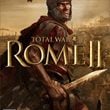Mechanics | Battle
Unit statistics
Each unit is described with a number of statistics that can be seen in the information panel on the left side of the screen.
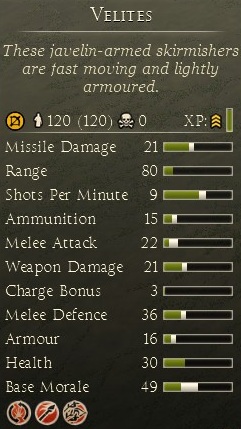
These are:
- Number of troops in the unit (along with the maximum number of troops) - the less losses the more effective will be your unit
- Number of killed enemies
- Experience - the higher the more powerful are your troops
- Missile damage - the ability of a projectile to cause damage to the opponent. Javelin is a lot more dangerous than rock.
- Range - distance at which your unit can attack your opponent. Javelin has a shorter range than an arrow from a bow.
- Shots per minute - how fast your unit shoots
- Ammunition - after running out of ammunition, the unit may melee fight or withdraw
- Melee attack - the ability to hit the target
- Weapon damage - the amount of damage
- Charge bonus - increases chance to hit and damage done during the charge and this value is the highest in the cavalry, chariots and war elephants.
- Melee defense - a chance to avoid hit in melee
- Armor - a chance to eliminate dealt damage
- Health - health points of your troops
- Base morale - unit morale; the higher the smaller the chance that it will run away from the battlefield
- Abilities (presented as icons) - each unit has a number of different abilities or characteristics that can be used in combat. When you move the mouse over them will get more detailed information.
When you move the mouse cursor over the missile damage or melee damage you'll learn further how effective is your weapon in piercing enemy armor. Some damage dealt will be eliminated by the armor and some will always get to the target, taking certain number of health points of your opponent.
Both defense in close order and armor include additional information on the effectiveness of shields in battle. In the former case, you learn by how much your chances to avoid an attack increase, and in the latter, you get to know by how much the damage from ranged weapons is decreased. Shields are affective only against attacks aimed at the front of the formation, due to which charges from behind and attacks at the flanks are more effective than a frontal attack.
Battle mechanics
During fight of two or more units, there are hundreds of computations in the background, affecting the outcome of particular clash. The higher the melee attack of your units and the lower opponent's melee defense, the higher the chance that the attack will reach the enemy. In case of projectile attack, the distance from the opponent and current weather conditions has the greatest impact on troop's accuracy. In addition, the chance to hit the enemy is also affected by experience of your troops as well as bonuses from leader abilities.

Once the attack reaches the target, it is necessary to check whether and how much damage is dealt. For this purpose the melee damage (or missile damage) is compared to enemy armor. As most units in Total War: Rome II deal two types of damage at the same time: normal and ignoring armor, attacks almost always take small amount of health points of your target. When the troop's health points drop to zero, he dies and size of the unit is decreased by one.
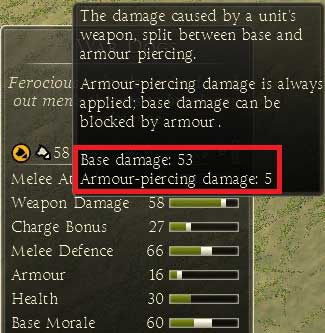
The effectiveness of units in the fight is also affected by fatigue. Exhaustion due to bad weather, constant running or protracted melee fight makes your soldiers tired out. The more lightly armored is your unit, the faster it can move on the battlefield and the longer is able to sprint. Skirmishers will be able to run for several minutes after the heavy armored legionnaires are completely exhausted.
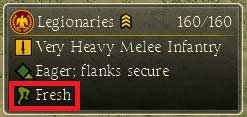
Another major bonus which can be accessed by any unit is charge bonus. This bonus is usually highest at units who use the impact momentum to break down enemy lines: cavalry, chariots or war elephants, but also a heavy infantry can use it often. Charge bonus increases melee attack and weapon damage in the first seconds of the fight, after attacking the enemy unit.
The last and probably most important characteristic of each unit is morale. You won't use even heavy armored soldiers, when they will flee to the forest after first losses. Usually the more elite and more skilled is the unit, the higher morale it has, but that is not a rule. Losses, fleeing allies, general's death - all these effects have negative impact on the morale. But the most dangerous situation is when your unit gets surrounded - the troop attacked from the flank or from the behind can start panicking very quickly.
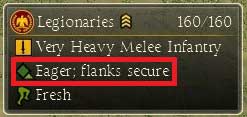
Troops at risk of panic can be easily found on the battlefield - they are symbolized with flashing white banner. If these are your units threatened by breaking down, withdraw them as soon as possible from the affected part of the battlefield and let them regroup. Another option is to move your general to the affected section of the front - it is often enough just to keep him there to make your units get back to the fight. On the other hand, if enemy units start panicking, you should focus your attack on them or order your projectile units to attack them. Panicking unit can be easily broke down and eliminated from the battlefield.
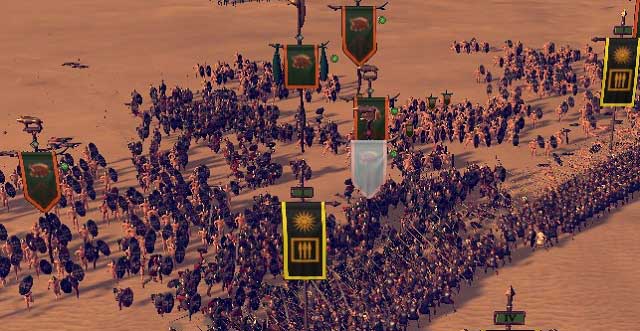
When using above information it is easy to see, that each unit has a sort of counter-attack. Lightly armored infantry with javelins are great for harassment heavy infantry. On the other hand slingers easily cope with javelinmen but won't be able to break through enemy shields. Fast cavalry or chariots will crush light infantry, but many times won't cope with the heavy one. In this case it would be more efficient to charge the flank or behind of the heavy infantry and then to withdraw quickly and prepare a new attack - thanks to such maneuver you'll be constantly earn charge bonuses.
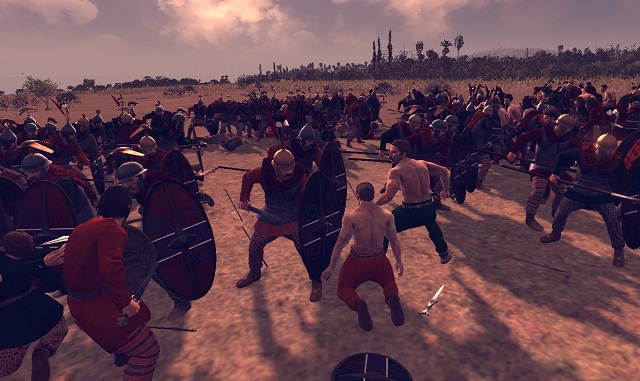
Abilities
Both the general and most of units in the game has access to various abilities. It could be flaming ammunition, special formation (Roman "turtle" - testudo), temporary strengthening unit's attack or shooting ratio or improving morale of certain unit.

In most cases special abilities affect only the unit using them. Increasing the reload speed will allow projectiles units to shoot more missiles before the charge while using a whip will improve attack of legionnaires. The more effective ability, the longer time is required to use it again. Usually you have to wait 1-2 minutes before you can use the ability again, but most powerful ones needs even 3-5 minutes to recharge and use them again.
In contract, general abilities usually have to be "aimed" in one of the units - you use LMB to do it. Such abilities are usually used to increase morale of fighting units or improve their attack and defense.
You are not permitted to copy any image, text or info from this page. This site is not associated with and/or endorsed by the SEGA or Creative Assembly. All logos and images are copyrighted by their respective owners.
Copyright © 2000 - 2025 Webedia Polska SA for gamepressure.com, unofficial game guides, walkthroughs, secrets, game tips, maps & strategies for top games.
